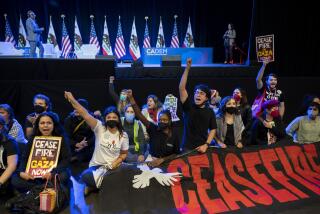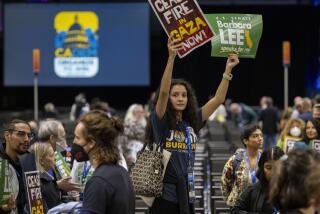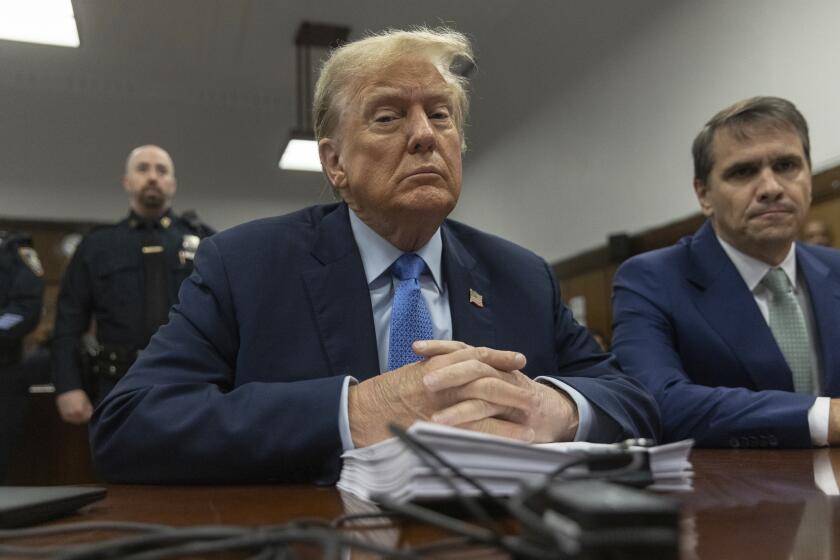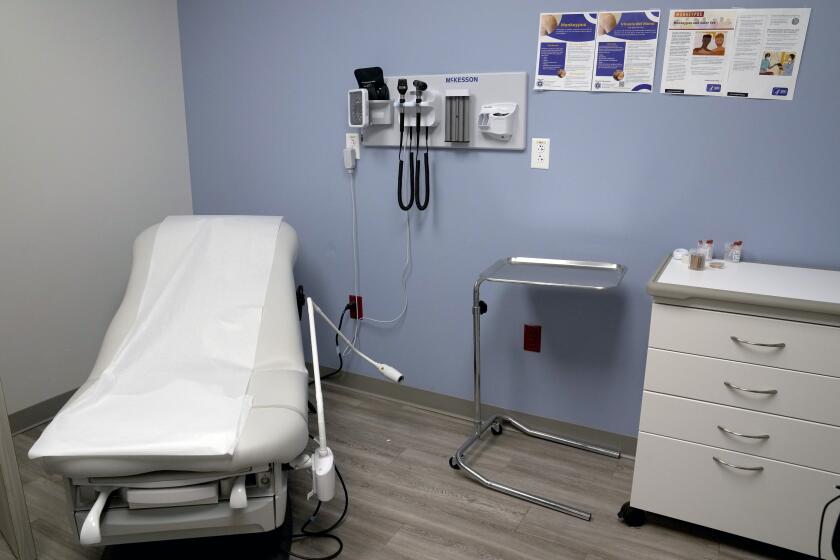Two conventions, one vast gulf: Republicans and Democrats appear to be speaking to different countries

What you missed on the closing day of the Democratic National Convention. More coverage at latimes.com/conventions. See other Democratic roundups here and catch up on the Republian convention here.
One night this week, the Democratic convention featured eight black women whose children had died in shootings or at the hands of police. A week earlier, Republicans repeatedly paid tribute to law enforcement.
In Philadelphia, the billionaire global warming activist Tom Steyer was ubiquitous. In Cleveland, Republicans put a spotlight on the plight of out-of-work miners and pledged to increase use of coal.
A speaker needing applause at a Democratic convention can always praise teachers. Republicans can reliably criticize public employee unions.
As the themes and tableaus of the parties’ conventions illustrated, a deep political gulf separates the country’s two major parties, their elected officials and their most reliable voters. And it is getting wider. Voters not only disagree on solutions to the nation’s ills, they hold starkly different views about what the problems are.
“Rarely in American history,” as Gov. Jerry Brown said here at the DNC, “have two parties diverged so profoundly.”
Both presidential nominees now face the question of whether either can bridge that divide — or whether they even want to try. Each entered the convention weeks with a strategic choice: Does the path toward victory involve reinforcing party loyalty in hopes of driving more on your side to vote? Or does winning require reaching across the tribal lines of American politics?
In Cleveland, Donald Trump placed a clear bet on the former path. Nearly every element of the Republican convention played to the anxieties and frustrations of the older white conservative voters who form the core of the GOP coalition.
His campaign strategists believe they can do better than the last two GOP nominees in motivating those voters to the polls. They’re also counting on Hillary Clinton’s unfavorable image driving down turnout among Democratic-leaning groups, particularly young people and minorities, who may not back her as readily as they did President Obama.
Clinton confronted a more complicated calculus.
Her party has proved the strength of its electoral coalition — winning the popular vote in five of the past six presidential elections. But its voters have grown frustrated at the gridlock that has resulted from a divided political system.
Moreover, Trump’s powerful appeal to the economic unease — and the racial resentments — of blue-collar whites has accelerated the trend of such voters identifying with the GOP. To make up for potential losses among them, Democrats need to increase their vote among suburban, college-educated voters who in the past have often sided with Republicans.
“We’re trying to bridge that gap, to try to make an argument that the politics of division are dangerous for our country,” Clinton’s campaign chairman, John Podesta, said at a meeting with reporters sponsored by the Wall Street Journal.
Election 2016 | Live coverage on Trail Guide | Sign up for the newsletter
The Democratic convention, culminating in Clinton’s speech, reflected that imperative. With speakers like former New York Mayor Michael Bloomberg and repeated descriptions of Trump as a dangerously unsteady authoritarian, they sought to make moderate, college-educated Republicans and Republican-leaning independents comfortable with the idea of crossing the line to vote for a Democrat.
Creating such inroads, however, is a tricky task. Clinton’s speech, for example, combined an appeal to independents and Republicans with a pledge to work with Sen. Bernie Sanders to implement a party platform that many of those voters will see as too liberal.
The differences between the parties have deepened steadily in the generation since the last Clinton won the presidency, and so has the animosity.
During Bill Clinton’s first term, fewer than 2 in 10 Democrats and Republicans had “very unfavorable” views of the other party; that total has nearly tripled, according to surveys by the nonpartisan Pew Research Center.
Elected officials reflect the polarized views of their voters and shy away from any move to cross partisan lines, even rhetorically. A telling example came in Cleveland when House Speaker Paul Ryan, at a lunch with reporters, was asked to name an accomplishment of Obama’s that he thought deserved praise. He said he could not think of even one.
When a reporter mentioned the hunting down of Osama bin Laden, Ryan brushed that aside, saying he saw Bin Laden’s killing in the context of an overall flawed foreign policy.
“I just see it as a series of huge missed opportunities,” he said, referring to the administration’s overall record.
Beyond the November election, a big question for the next administration will be whether that sort of mutual partisan disdain will continue to block legislation, said Neera Tanden, a longtime Clinton advisor who heads the Center for American Progress, a Washington-based advocacy group.
If Trump wins, it’s unknown whether he and congressional Republicans, whom he has largely kept at arms’ length, will be able to agree on a legislative agenda. Ryan has suggested that Trump will implement the plan that House Republicans have put forward, but Trump already has rejected major elements of it.
If Clinton defeats Trump, the key to her next steps will be how “Republicans think of that loss,” Tanden said. If, for example, Republicans feel they lost because of a failure to reach out to Latinos, that might soften resistance to immigration reform, Tanden suggested. A particularly bad showing with women might ease the way toward a compromise on paid family leave.
Of course, many Democrats made similar predictions four years ago about the impact an Obama reelection might have. Leading Republicans undertook a postmortem of nominee Mitt Romney’s loss in 2012 and concluded that the party must embark on immigration reform, a top Democratic priority in order to bring in more voters.
But hopes of a new era of bipartisan action foundered quickly, and the intense dislike many Republicans have for Clinton could ensure that cooperation remains elusive.
It’s also possible, however, that the formidable partisan gridlock that has persisted into 2016 could dissolve sooner than many think, a casualty of an even more powerful force — the nation’s rapid demographic changes, said Chris Lehane, the former Bill Clinton strategist who now serves as the head of global policy for Airbnb.
The stalemate is historically unusual, reflecting a nearly even match-up between two groups with vastly different priorities — the Republican coalition of mostly older white and non-urban voters and the Democrats’ ethnically diverse, younger coalition, which is heavily concentrated in the nation’s cities.
For the past decade, the balance between the two has given each party the ability to block the other’s priorities. Such an extended impasse is rare in the U.S. and may prove temporary.
Within eight years — the length of a two-term presidency — the demographics underlying that split are expected to shift dramatically. By 2024, roughly 75% of voters will be members of the millennial generation or younger, Lehane said. That would put the needs and political preferences of a much more racially and ethnically diverse generation at the center of U.S. politics.
“The tectonic political plates,” he predicted, “are going to shift in a very significant way.”
ALSO
Analysis: Now that she’s made history, Hillary Clinton must build trust
Hillary Clinton’s acceptance speech ratings will fall below Donald Trump’s
How Hillary Clinton’s plans break from Obama’s policies on Syria, trade and other issues
More to Read
Get the L.A. Times Politics newsletter
Deeply reported insights into legislation, politics and policy from Sacramento, Washington and beyond. In your inbox three times per week.
You may occasionally receive promotional content from the Los Angeles Times.






